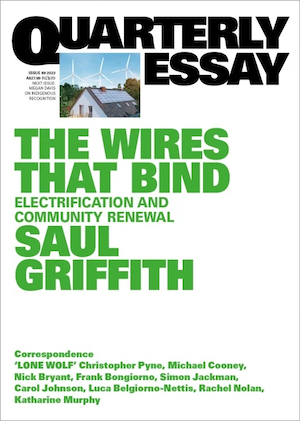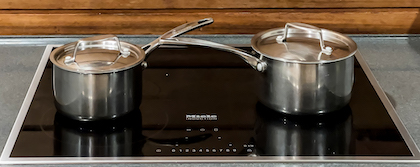Australia’s energy transition
Electrify everything

If an engineer is asked to describe the electricity system to a class or a conference, he or she will probably start with a diagram of generators – solar farms, wind turbines, and perhaps a legacy gas power station – before moving on to big batteries, transmission lines, street transformers, distribution lines and finally the three-pin outlets in your house.
Saul Griffith’s Quarterly Essay The wires that bind: electrification and community renewal, takes a completely different perspective. His first diagram starts at the home with cooktops, lights, and the electric cars we will all own in time.
It’s a thorough description of our electricity system, and what that system might become as we take advantage of existing and emerging technologies in generation and storage, and as we invest in the networks to connect us all up – connections varying from community grids (as he is organizing in his Electrify 2515 project in the region north of Wollongong), through to AEMO’s Integrated System Plan to join up our nation’s widely-separated renewable energy hotspots.
His essay is more than that, however. He stresses the role of the household in driving this transition. For a start people can replace their gas ovens, gas cooktops, gas heaters, and gas hot water heaters with electric appliances. Then they can invest in “Home Energy Management Systems” to ensure that the technology in their houses does its part in matching demand to supply – running the dishwasher when solar supply is at its peak, charging the electric vehicle (a battery on wheels) during the day and feeding power back during the evening peak – while saving themselves money.
Particularly refreshing in Griffith’s approach is his rejection of the dismal sackcloth-and-ashes approach taken by many self-identified environmentalists. We can still have comfortable houses (using heat pumps of course) and use our cars. In fact he envisages a trebling of per-capita electricity consumption as we dispense with other energy sources. At the same time, however, he does suggest how electricity renewal can shape community renewal, acknowledging that a long commute in an electric car is no more pleasant than a long commute in a gasoline-powered car.
To date Griffith’s household-side vision has been missing in Australia. Many journalists, noting the 56 percent electricity price rise forecast in the Commonwealth budget, have lazily assumed that people’s electricity billswill rise by 56 percent, without taking into consideration the possibility of people making an intelligent demand-side response.
Most energy conservation and efficiency-improving investments Griffiths recommends are good ones, yielding households returns far better than anything to be obtained in bank deposits or the stock market, and those returns are tax-free. Most investments are so attractive that they would make sense (yielding a positive net-present-value) even if financed at usurious credit-card rates. In recognition that many people are cash poor however, he suggests that there be more low-interest loan facilities for people to invest in household energy efficiency.

Clean energy one cooktop at a time
Some examples of the savings to be made in replacing appliances, including house heating and cooling, are in a Conversation contribution by Rachel Goldlust of La Trobe University: Want an easy $400 a year? Ditch the gas heater in your home for an electric split system. Like Griffith she emphasizes the need to get rid of our gas appliances, pointing out that Victorian households are particularly dependent on gas. (If you are hooked on a gas cooktop, ask one of your mates to let you try out their induction cooktop.)
Griffith’s essay presents convincing hard numbers, such as a comparison of our present average electricity price of $27.5 c/kWh, with lower prices for systems incorporating 100 percent renewables and batteries, including 11.9 c/kWh for a well-designed community solar system. His estimates all include allowances for the costs of storage and firming, effectively dismissing the Angus Taylor recitation about the wind not always blowing and the sun not always shining.
The impediment that Griffith doesn’t address, however, is that many Australians have little awareness of what they are paying for electricity. They may be able to tell you how much they pay for a litre of gasoline, and how many litres their car uses per hundred kilometres, but at the same time lack any idea of what they are paying for each kWh of electricity, or how many kWh they are using a day. If they had such awareness people would surely be doing more productive and rewarding things than turning off their modems at night (seriously recommended by one consumer spokesperson) and would be turning to real savings in insulating their homes, buying batteries, and replacing energy-guzzling appliances.
Developing price awareness is a task for journalists, politicians and utilities, but to date they have been letting us down. Press reports about electricity price changes are almost always in the form “this will cost/save the average household $X a year”, instead of an expression of the price per kWh.
The other impediments to re-wiring, requiring policy attention by all tiers of government, are the physical and contractual ones in wiring apartment blocks, particularly for electric vehicles, and ensuring that renters can benefit from re-wiring. For anyone with a free-standing house with a garage Griffith’s essay provides an immediately useful guide to action, but as more Australians choose to live in apartment blocks, and as more Australians by choice or necessity are renting, the need for appropriate policy responses becomes more urgent.
A global clean energy arms race has broken out: we have to join it
In August last year the US Congress passed the Inflation Reduction Act (IRA). Its passage was largely unnoticed, possibly because of its name. But its name, chosen for political purposes (even Republican voters are turned on by the term “inflation reduction), disguises its true content.
In fact it involves a massive $US500 billion to $US1000 billion set of tax breaks, concessions and direct subsidies to bring about a clean energy transition in the US. (Perhaps the Biden Administration should call it the Make America Green Again Act.)
On last weekend’s Saturday Extra, Geraldine Doogue interviewed Kane Thornton of the Clean Energy Council and Alan Finkel about the global and Australian implications of the IRA.
In terms of the health of the planet, it’s great news. And in terms of lifting America’s poorer regions out of poverty, it’s also good news. But because of its protectionist aspects it’s also a disruption to the global trading order, and it is being met with similar moves by the EU.
This leads to the question whether it’s better to save the planet or to save the last remnants of the Bretton Woods order, but the participants did not go down that path.
They did, however, remark on the competitive implications for our nascent green hydrogen industry and other developments where we hope to prosper from our ample supply of green energy resources. Finkel, for example, suggested that in this new global environment we may reconsider whether we should develop an export hydrogen industry. It may be far better if we generate hydrogen as a complement to our iron ore industry, using hydrogen to reduce iron ore to iron and to develop a competitive iron and steel industry. This would be in keeping with our much vaunted (but seldom implemented) desire to see further processing of raw materials in Australia.
The 15-minute interview covered great deal of ground. Had it gone on the participants would have surely gone into the pressure Australia’s coal and gas industries will face when the US can join with the EU in taking the high ground on emissions.
Power system developments – we should get through the winter
Because we are trying to catch up after the Coalition’s tardiness, and even outright hostility, to investment in renewable energy, there is a small but real risk that Australians in the NEM region will experience electricity shortages this year.
You can play a part in ensuring there isn’t a shortage. If you live in New South Wales, go easy on your evening use of electricity, and if you live in Victoria get rid of your gas appliances as soon as possible. Both will save you money.
New South Wales
The coal-fired Liddell power station in the Hunter region of New South Wales is due to close down on April 28, according to the Newcastle Herald. Completed in 1973, in its heyday it was capable of generating 2000 MW to the state (and later the NEM) grid, but even in the absence of any incentives to close down thermal power stations, it would be prohibitively costly to keep it going. According to Choiceenergy, who provide a full accountof the impact of its closure on New South Wales and on the NEM, it has been providing little power in recent months, and there is plenty of new capacity installed or coming on stream.
David Leitch, writing in Renew Economy, is a little more cautious about Liddell’s closure – Never mind Eraring, the Liddell coal closure in April is the one to watch. He believes that because the interconnections between New South Wales and other states are still inadequate, and because some new capacity is slow to come on line, there could be problems in meeting peak evening demand in coming months.
If, in the coming winter months, there are problems with early evening supply, expect the Coalition to make a lot of noise about it. Matt Canavan has already said Liddell should be kept operational on a care and maintenance level, even though that idea was not supported by the then-in-office Coalition state government.
Gas
The ACCC has produced an interim update on the gas supply-demand outlook for the east coast in 2023. They believe that the risk of a shortage is significantly lower than they had estimated in January. Since then another 27 PJ has become available, and only additional 3 PJ is needed to ensure adequate supply: Gas shortfall in 2023 less likely as gas supply outlook improves.